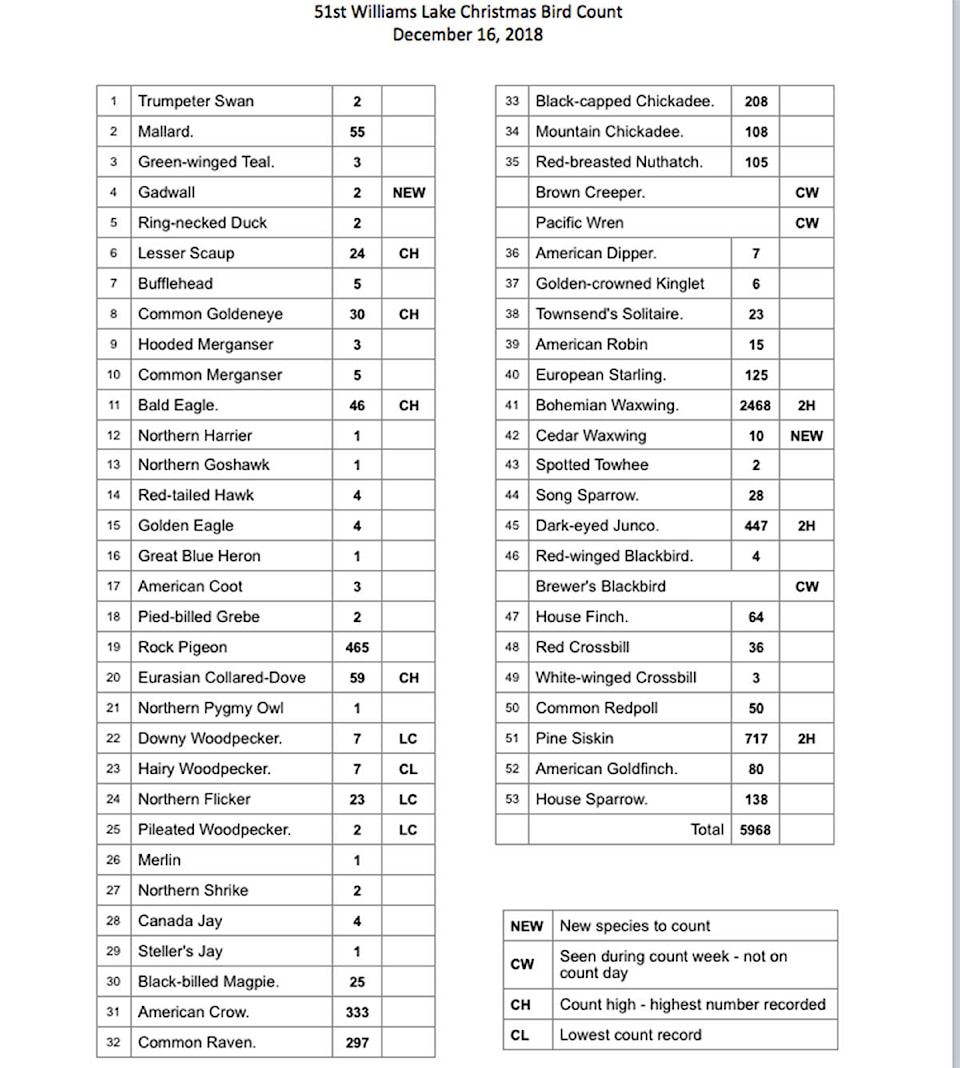Hundreds of birds were counted in Williams Lake as the unusual weather conditions made for an up and down count of unseasonal and seasonal species respectively.
Dec. 16, as 35 bird counters set out at first light on the annual Williams Lake Christmas Bird count, wind speeds at the airport were being monitored at 45 km/hr gusting to 71 km/hr and were to increase during the morning before moderating only slightly for the remainder of the day.
Weather plays a key role in the success of the bird count and no condition affects it as adversely as high winds. Birds tend to stay hunkered down, calls are often drowned out and the constant swaying branches make it difficult to pick out the movement of birds.
One factor which would seem to provide an advantage was the exceptionally mild conditions but this proved to be a detriment as many of the bird feeders were strangely quiet with some normally productive feeders showing a complete absence of birds. Partially explaining this would be the lack of snow cover and a good seed and berry crop allowing birds to forage widely without the need to concentrate around a well-stocked feeder.
The wind was also proved to be a double-edged sword pushing away the ice forming along the edges of Williams Lake and allowing several duck species to remain beyond their normal departure dates. One duck species, the Gadwall was recorded for a count first when two males were spotted at Scout Island. The Gadwall is a fairly common dabbling duck in the breeding season in the Cariboo but is usually one of the first to leave in the fall. Other ducks to remain included a record 24 Lesser Scaup and 30 Common Goldeneye.
Read More: Endangered pelicans have “guarded prognosis ” after Puntzi Lake rescue
A pair of stately Trumpeter Swans also remained at Scout Island as the winds and the moderate temperatures kept the channels through the marsh open. These swans will stay as far north as conditions allow and can now be found in good numbers on larger open waters such as Quesnel Lake throughout the winter.
This year’s count was again a tale of the waxwings. Last year a record number of Bohemian Waxwings contributed to over 40 per cent of the overall total. This year the waxwings were back again in good numbers only slightly lower than last year, but to add to the variety, Cedar Waxwings were also added to the count for the first time. Cedar Waxwing is not uncommon as a breeding bird but rarely overlap with the Bohemians which swarm into the area from the north to spend the winter.
Another bird seen in record numbers was the Eurasian Collared-Dove which have swept across the continent from a single point of introduction in Florida. The first one on our count was seen in 2011. Last Sunday 59 were recorded including a single flock of 30 along Pigeon Avenue. It will be interesting to see where this increasing population levels out and what effect it will have on native species.
One bird which doesn’t seem to mind the wind at all is the high flying Bald Eagle and 46 were tallied as they tracked across the 450 square kilometre count area.
The count also revealed an alarming reduction in woodpecker species. All our regulars; Downy, Hairy and Pileated Woodpeckers and the Northern Flicker were down considerably. The Hairy Woodpecker had its lowest ever number on the 51 years of the count with only seven seen. An average number would be around 30 with a high of 50 in 2006. There is probably some correlation with these numbers and the lack of birds at feeders, but not entirely explained considering typical feeder species such as Chickadees were only a little below average.
As the day wrapped up, the count species finally stood at 53 which is marginally higher than the recent average. Notably absent from the list was the Pine Grosbeak which dominated the count last year with 340. This is not all that unusual for these irruptive boreal forest finch species. The final tally on individual bird numbers was 5,968 which surprisingly was only 500 less than last year’s record count and comprised once again of a significant proportion of Bohemian Waxwings.
The Williams Lake Field Naturalists would like to thank all who participated in the field and those that watched their feeders - often with little reward.
patrick.davies@wltribune.com
Like us on Facebook and follow us on Twitter
